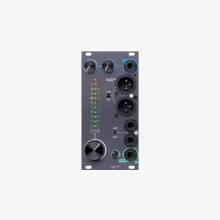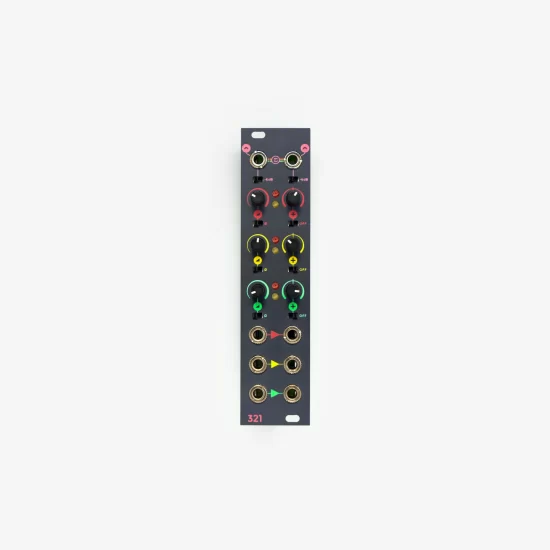Mᴼᴺᴱ Masterone
265,00 € + VAT
In stock
Description
The Masterone is the first Frap Tools module designed to be connected exclusively with non-Eurorack equipment.
It features four separate output sections with different Neutrik connectors and adjustable gain levels to suit the most common live and studio situations (and even some uncommon ones).
With no inputs and just large-format outputs, it pushes even further the concept behind the M module: being a Eurorack system’s gateway to the outside world.
Key Features
Two XLR connectors (left and right) provide a balanced output with the expected 6 dB extra gain. In many cases, they can allow bypassing a DI box.
These outputs are very similar in concepts to the ones on the M module, but with large ¼” jack connectors. It is possible to patch standard TS cables and use them as unbalanced outputs, or use TRS cables to interface them with balanced equipment (the ground is routed to both the ring and the sleeve, for a better performance than regular unbalanced outputs).
If the two stereo outputs are too hot, a set of switches can attenuate them. The Line/Mic switch on the XLR outputs attenuates them by ~30 dB, while the Line/Inst switch on the TRS outputs attenuates them by ~15 dB.
The Headphones section allows you to monitor the Master output with an independent volume knob and, at the same time, take advantage of the PFL function on the Channels and the Groups. Rotate the PFL crossfader towards the blue section to blend the PFL modules with the Master sum and check if everything is okay before launching the next scene.
Should you need an extra monitor on stage, or run the whole system through a vintage amp in the studio for parallel processing, the auxiliary monophonic outputs is the answer. It provides the sum of both channels in a handy, pseudo-balanced output with a dedicated fader: attenuate the line level by 15 dB, or amplify it by 6 dB.
A detailed VU Meter monitors the signal amplitude from -40 to +15 dB with peak memory on the upper LEDs.
Master Family Comparison
VU meter | 2×12 LED | 2×5 LED |
VU meter peak memory | ✓ | ╳ |
Pseudo-balanced outputs | ¼" TRS | 3.5 mm TRS |
Balanced output | Stereo/Dual mono | ╳ |
Headphones output | ¼" TRS | 3.5 mm TRS |
Aux input | ╳ | 3.5 mm TRS with PFL |
Pseudo-balanced mono output | ¼" TRS with fader | ╳ |
PFL circuit | Crossfader latching | Crossfader |
Pseudo-balanced output level | Line/Inst | Line |
Balanced output level | Line/Mic | ╳ |
Fader knob | ⌀ 20 mm | ⌀ 20 mm |
Learn
Learn
Learn
Specs
Size | 12 HP |
Depth | 38 mm |
Current draw | 80 mA @ +12 V 80 mA @ -12 V 110 mA @ +12 V With headphones at high level (250 Ω) 105 mA @ -12 V With headphones at high level (250 Ω) |
Recommended warmup time | 30 min |
¼" TRS output impedance | ≥ 35 Ω (unbalanced) ≥ 70 Ω (pseudo-balanced) |
XLR output impedance | ≥ 220 Ω (line level) ≥ 440 Ω (mic level) |
Maximum output level before clipping | ≥ 17 dBu |
Output gain scale referred to group output | 5 dB |
Headphones gain scale referred to group output | 7 dB |
Frequency response | 0.01 to 40 KHz |
Harmonic distortion | < 0.3 % |
More details on the Manualone.
FAQ
A. Use
Our modules are packed with high-quality components that demand a proper power supply and can get sensibly warm.
That is its normal temperature and we can guarantee their performance.
You always need at least one group if you plan to incorporate a master module in your setup. It is not possible to connect any channel module directly to a master module.
The CGM is designed to let you connect up to eight channels (C or QSC) to one group (G), but there is no way of connecting the same channels to two or more groups.
Yes, to take advantage of the Master module’s functions (PFL, headphones, final gain stage), you need at least one group.
We designed the group (G) module together with the classic mono channel (C), which is 6HP wide. After the QSC release, we developed a new Link System with wider plugs that allow you to connect more QSCs in a row.
If you need to connect more QSCs, check your local shop for cable availability!
If you just need to connect a QSC, the classic group-to-channel cable works great, too.
If you experience an abnormal panning on the CGM, check your case’s power supply and your system’s overall power consumption. We experienced that the CGM system sometimes has trouble working in a system close to its maximum Ampère output. An unbalanced power supply may cause the audio to be louder on one channel than on the other.
Try staying below 80% of the total amperage or switch to a more powerful PSU to solve this issue.
The Mute button closes the first VCA of the channel, thus preventing the sound from being routed through all the other VCAs (FX sends, pan, main fader).
The Solo in Place button isolates some channels and mutes the others. However, the mute function it performs is different since it affects the channel after the fader: the sound will still be routed to any pre-fader VCA such as Direct Output and FX Sends (when set to Pre-Fader Mode).
In other words, the Mute button works pre-fader, while the Solo in Place works post-fader.
B. Design
We have two main kinds of capacitors.
The first one is necessary to AC-couple the audio signal: they prevent any unwanted DC offset, and they offer protection against wrong connections. For this reason, you can patch nearly every input to every output, and the worst thing that can happen is some pops or some silence.
The second one is power filters to guarantee a cleaner current flow across the case. They might sound a bit over the top, but we must remember that a Eurorack system is not something that comes straight out of the factory. Instead, every Eurorack setup is unique and may change according to the musician’s need. For this reason, we want to add as much protection as we can, both to avoid issues with our modules and to ensure that even the other modules behave correctly. We use a wide mix of capacitors in our modules: ceramic, electrolytic, tantalum, and multilayer. They can be assembled thru-hole or SMD, according to what gives the best balance between result and space. For example, all the electrolytic capacitors are mounted thru-hole because they perform better according to our tests.
However, the capacitors have zero impact on the power draw, on which you can read in this other FAQ.
Power draw should always be related to what a module does.
Generally speaking, there are modules like SAPÈL that undoubtedly consume more than other random generators. However, SAPÈL is a double module, so a fair comparison would be between it and a pair of similar modules. The same can be said for FUMANA, the most power-demanding filter bank. However, it is also the only Eurorack filter bank with 32 analog bandpass filters, half of which have a 48 dB/oct slope. So, also in this case, a fairer comparison would be between FUMANA and TWO other 16-band filter banks, which leads to similar power consumptions.
More in detail, we engineer our modules to be safe to use. To protect both the modules and the rest of the case, we add a proper buffering stage to every input and output: even if a single buffer doesn’t draw that much power, all the ins and outs piled together can significantly impact the final power draw.
C. Shop
Yes! We opened our online store in October 2022. Check out the full catalog!
Our resellers receive our modules exclusively through our distributor, so we do not have access to the individual shops’ orders or stocks.
We restock every module at least once over a year: we focus on a module’s batch at a time, then we move on to the next one, and so on.
If you want an estimated delivery time for a specific module, drop us a line! We’ll be happy to answer you.










